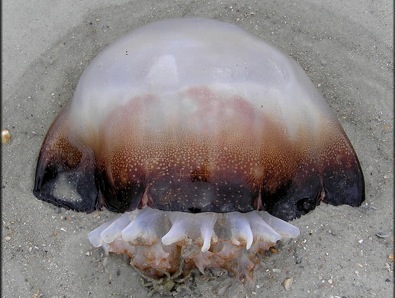
Stomolophus meleagris: Edible Jellyfish
“Music to the teeth” is what the Malaysians call them.
Americans may not eat jellyfish, but the rest of the world does, several hundred metric tons a year at around $20 a pound. It’s a many million-dollar business. And at least two or three of those drifting edibles are found off almost all the shores of America, one of them in pest numbers in Florida waters and the Gulf Coast. I don’t go looking for the creatures but when they turn up in my castnet they comes home with the rest of the catch. The catch, however, is that jellyfish have to be processed over then next several days to make them edible.
Actually there are several methods to “cure” the jellyfish all involve drying while retaining color and firmness. In fact, there are Jellyfish Masters like wine masters. The curing process is as much an art form as a science. Traditional methods can take more than a month. Express techniques three days. The at-home compromise is about a week. It’s not complicated. It just takes… some time. It also helps if you like to eat jellyfish.
I can remember the first time I had jellyfish in a restaurant. It was more than 30 years ago. I had a Taiwanese friend and went out to dinner often. That’s when I first learned that nearly every Asian restaurant has two menus, one for the Americans and one for the native crowd, and they don’t have the same selections. To this day I still order a particular salt-fried shrimp that is never on the main menu. My friend always had the custom of ordering three dishes for the two of us. And one day for the third dish she ordered jellyfish salad. It was delicious and crunchy and I was hooked.
There are actually several edible jellyfish, all processed the same way as far as I know. The most common one is the Cannonball Jellyfish, or Stomolophus meleagris (sto-moe-LOAF-us mel-EE-uh-gris) which in Dead Latin-mangled Greek means “speckled crested mouth.” Several copy-cat web sites say it means “many-mouthed hunter” which is quite absurd. Stoma in Greek means mouth. Lophos in Greek means crest. Meleagris in Greek literally means black and silver but in use means speckled. It is also the Greek name for the guinea fowl. I have no idea how “speckled crested mouth” got perverted into “many-mouthed hunter.”
For a creature few Americans outside of US shrimpers know about, the Cannonball has generated a lot of talk, research, anger and debt — no deaths that I know of (I had to mention that.) Found from Maine to Brazil, and from Southern California south on the west coast, it is a pest from about the latitude of North Carolina south. In certain months they can make up 16% of the biomass in shallow near-shore waters and estuaries, the latter a favorite haunt. Sometimes in the spring and fall there are so many Cannonballs in shrimp nets that the haul is too heavy to pull on board and the entire catch has to be dumped. On the other side of the issue, there have been attempts to harvest that very same jellyfish and make it into a commercial product, if only for shipping to the Orient where our domestic product is better than their native product. That, too, has gone bust and emptied a few wallets.
While found in the warmer months in northern latitudes they are a common species in late spring and early summer, particularly around the Gulf Coast, Florida and the Caribbean. During this time they often litter the coast. If you find them on shore leave them there. Get your catch while still alive and in the water. It is dense, rigid and holds it shape even out of water. They are good swimmers and can have a bell diameter up to 9 inches through. These jellyfish don’t have tentacles per se but they do have 16 fused arms that push food towards what is its mouth/anus (these are simple creatures.) The bell can vary in color from bluish to yellowish and they are typically darker around the bottom edge.
The Cannonball has a mild if not unnoticeable sting that is usually harmless. However, some folks are allergic to it and for them it can be problematic so best avoid being stung. It has toxins that can cause cardiac problems and is also harmful to the eyes, so handle it with care. For the rare individual who is allergic to it, they should also not eat it.
Jellyfish (which really aren’t fish but relatives of coral and sea anemones) have to be processed soon after catching. No more than six hours is a good rule, immediately is better. They can be kept in seawater or put on ice. First you remove the trailing parts (if it were a mushroom, the stem.) That leaves you with the round part, the umbrella which has three layers, the exumbrella or the upper surface, the subumbrella or inner surface, and in between them the mesoglea (which means gelatin dessert.) The umbrella is scraped to get rid of any mucus then washed. Both parts are used and can be processed at the same time but commercially the perfectly preserved globe part — flattened to a pancake — is choice.
Don’t exceed a gallon of jellyfish per gallon of water, a roughly one to one ratio. In the first phase in a two gallon container soak the parts in a brine that is 7.5% salt and 2.55% alum which if working with a gallon is 11.25 ounces (315 grams) of salt added to the gallon of water and almost four ounces (107 grams) of alum added to the same gallon. Soak them two or three days, then transfer to a second solution. This is a brine of 15% salt and 1% of alum, or 22 ounces (615 grams) of salt to a gallon of water, and 1.5 ounces (42 grams) of alum to a gallon. Soak them again for two or three days. Here methods vary.
In part three you can take them out of the brine, dry them, coat them with salt and let them dry for several days, turning often. You can also add weights to flatten them. Alternatively, you can put them in a third brine of 25% salt, or about 2.75 pounds of salt to a gallon and let them set for seven days. Then drained, dry and salt. The jellyfish are piled up to a foot high, one on top of another, and seven to eight pounds put on top for about three days. This flattens them like a pancake. They they are bagged and stored.
The final product is mild in flavor and light yellow to clear in color. To prepare for use the cured jellyfish are soaked in lots of water for several hours, over night is best, then cut into strips and scalded. Then they are used, often as a cold plate with a dressing soy sauce, vinegar, sugar, and sesame oil. They can also be cooked with other meat and vegetables.
A third curing method if you are really in a hurry is soak them in 15% salt and 10% alum for 48 hours… ( 22.5 ounces salt, one pound of alum per gallon) wash, drain for two hours, dry at 30C/86F for 9 to 12 hours in a mechanical dryer. If you want a bigger curing formula you would treat 132 pounds of Cannonball jellyfish with 81.5 pounds of salt, 6.5 pounds of alum. Then adjust the first recipe accordingly after that, 163 pounds of salt and about three pounds of alum. Ideally you have a one to one ratio of water and jellyfish, or less jellyfish but not more. A fourth method is simpy putting them in rock salt for a few days. I don’t know much about that one but it sounds interesting.
According to a 2001 study a desalted Cannonball is about 95% water and 4 to 5% protein. It is very low in calories and mostly collagen. For four ounces the nutritional values are 30 calories, none from fat; 120 mg of sodium and eight grams of protein. What does it taste like? Bubble wrap with dressing. For over 1,700 years, Asians have been eating jellyfish for medicinal reasons to treat high blood pressure, arthritis, bronchitis and reportedly to prevent cancer. By the way, the Cannonball collagen has suppressed induced arthritis in laboratory rats. In fact Auburn University holds a patent on an arthritis treatment involving jellyfish collagen.
Among the edible jellyfish are Aurelia aurita, Catostylus mosaicus, Cephae cephea, Crambione mastigophora, Crambionella orsini, Dactylometra pacifica, Lobonema smithi, Lobonemoides gracilis,Nemopilema nomurai, Rhopilema esculentum, Rhopilema hispidum, Rhopilema verrilli, Rhizostoma pulmo, Stomolophus meleagris and Stomolophus nomurai. The Rhopilema verrilli is also found in the Atlanta on America’s east coasts. And I well remember as a kid watching Aurelia aurita off the coast of Maine, never guessing it was edible.
There are actually two variations of Cannonball Jellyfish in local waters. On the Atlantic side is the kind with a brown rim around it, picture above. It is also called the ruby-lipped cannonball. The ones found in the gulf coast are whiter — snow white Gulf Balls, pictured below. The latter are the preferred ones for market. There is no taste difference, just customer preference in Japan and Korea… think white chicken eggs/brown chicken eggs kind of thing. Apparently the environment would be better off, too, if we ate more Cannonball jellyfish. They are veracious predators eating plankton, fish eggs and larvae. So if their population is reduced we’d probably have more fish.
Are the toxic jellyfish? Absolutely. The sea wasp– Chironex fleckeri — of northern Australia can kill you in three minutes. It has enough toxin to kill 60 at a whack. Locally, Portuguese Man o’ War can make your day miserable. Avoid any jellyfish with long tentacles.
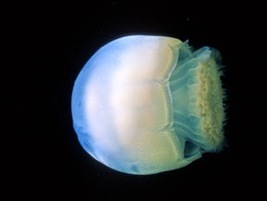
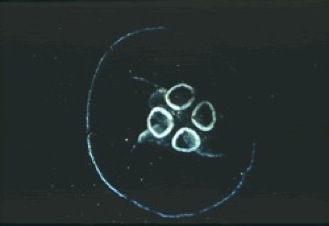
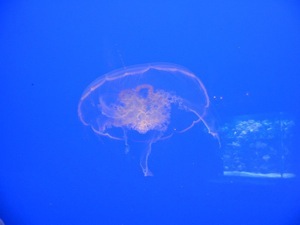
Aurelia aurita
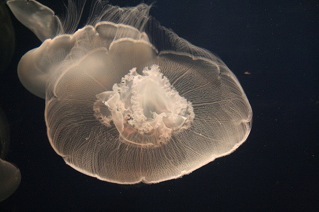
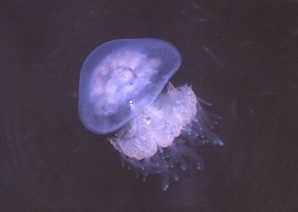
Rhopilema verrilli




My good friend Jack Rudloe of The Gulf Specimen Marine Acquarium in Panacea Florida went to China a few years ago and worked with the Chineese, who love jellyfish and have creatred several ways of processing them commercially, to help market a nother seafood resource. I tasted some of the product he brought back from China and it was like a tender jerky in a way with a salty marine taste. I thought it very good. Jack was trying to create a bi-catch market for Florida shrimpers and, as the Chineese were willing to foot the investment, it was a great idea. Problem was that since it is a very seasonal catch he found little interest from local shrimpers or fishhouses to handle Jjellyfish. I thought this odd as both are always grumbling about not makeing enough money in the commercial fishing industry. Especially since the shrimpers could catch tons of jellyfish at a time at a rate about 5 times what they get for shrimp. Oh well, hopefully American fishermen will come into the 21st century one day and participate in a growth industry which could be profitable for all concerned. Meanwhile I enjoy catching them in my cast net in Setember and October, and after a few days drying in rock salt I slice them and either bread and deep fry the slices, or cube and use in a stir fry as you would Tofu. Experiment and enjoy.
What particular species?
i want food now
Just had sea jelly for the first time about a week ago, it was served covered in a spicy dressing. And was like eating a soggy rubber band but, was overall tasty. I recommend trying it at least once.
thank you for an informative article. I woke up this morning thinking about world hunger and how we are, literally in this case, swimming in food. I just discovered another “pest” as a great food source : Mullet. I live on the Texas Gulf Coast and wondered for years why we disdain this plentiful and easily obtained food source. Just this past year I learned how to prepare them. Now , if I dont catch the “real” fish as my friends and realatives refer to the ones you have to pay the govt to catch, I dont go home empty handed ! I’m thinking this year I might waive the cover charge on my participation in the food chain and just go for the “trash fish” : jelly fish, mullet and HORRORS- catfish !
James,
You are absolutely correct.
My Father and I never agreed on much but he did say that “One man’s meat is another man’s poison.”
The idea of “sustainability” and “renewable resources” is finding food and raw material sources that are currently in abundance even if it means going outside historical and cultural norms. What’s the point of cutting down natural forest to raise even more cattle if “trash” fish are healthy and abundant…and higher in protein. If I recall correctly, chicken and fish are 20-25% protein, where pork and beef are 10-15%.
I just had lunch in Honolulu with garlic cucumber and jellyfish. Not the first time I’ve eaten jellyfish but it was particularly good so I thought I would see which kinds are edible. You say alum is used in curing and I assume it is potassium alum. The reason I ask though is that there are at least 5 different types of alum occurring naturally in the deserts on the Pacific coast of South America.
Let’s not forget that Asian carp in America’s rivers and lakes and the Burmese python population running wild in Florida. Imagine what can be done if they were caught and sold for profit instead of being just buried and incinerated like they are doing now.
I am working on a jellyfish report for class!
I often go out to Mayport Fl and several times noticed some people pulling in large jelly fish. Once I asked what they did with them but I didn’t get a good answer. Your sight is terrific. I am blogging about gardening and such and I like to use some of your information on the jelly fish. I would like to have your permission to do so. back40gardening.blogspot.com. Thanks. Margareta
Sure, no problem.
I’m a little confused by your photos. You have a moon jellyfish pictured with the cannonball as the same species. These are two entirely different jellies. Which makes me wonder which one you are referring to to eat. I would love to try this, as I dive here in the Gulf, but don’t want to eat the wrong thing. Good information is hard to come by and I really enjoyed you site. If you could clarify I would feel better about eating them. Thanks!
The article specifically lists the edible species. What might be confusing is the cannonball name at the end of the article. I’ll remove it.
we have so many smart people around ,,I am pretty shurre that we will find a inovative way to handle this jellyfish invasion.maybe some day ,a scientist will discover the hidden value of this creatures for pharmaceutical companies,
Jellyfish (cured) are very expensive in Asia, local wet market sell
a typical cured one–about 10 inches in diameter and less than 1/2 inch
in thickness–for US10.- minimum; yet Chinese restraunt will charge
at least five times for the same size.
Chinese treats special guest with jellyfish only at special occassion–banquet, it is not for casual consumption; jellyfish, together with
other cold-cuts, i.e. drunken chicken, beef slice, etc., are typical
appetizers in Shanghai banquet.
I am trying to research ways to brine my own jellyfish without using alum (potassium sulphate, right?). It is very hard to get clear information on whether this is considered a heavy metal, and whether there are heath risks (seems there are) both to us (though we can flush the jellies of most of the alum) and to the surrounding ecosystems near the brine wastewater. Any clarifications or suggestions would be appreciated. I read somewhere that oak leaves used to be used in the brining – which as I understand, is intended to reduce the water content in the jellyfish and preserve its crunch and form? Thank you.
I have read enough about the toxic effects of aluminum on the body. I avoid aluminum pans, baking powders containing aluminum, and just about any food ingredient for that matter. Anything processed with alum I would never touch.
a·lum
ˈaləm/
nounCHEMISTRY
a colorless astringent compound that is a hydrated double sulfate of aluminum and potassium, used in solution medicinally and in dyeing and tanning.
any of a number of analogous crystalline double sulfates of a monovalent metal (or group) and a trivalent metal.
plural noun: alums
It is also in pickles. And I used to drink the pickle brine!!!!!!
Hi.
There are others regions in America (I mean the continent) that fishing Stomolophus meleagris. Like Mexico, Ecuador and Honduras. Not only USA.